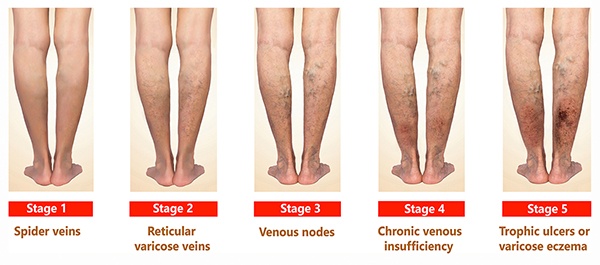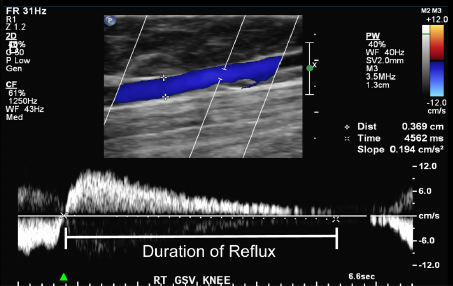Chronic Venous Insufficiency (CVI)
The vascular system is comprised of our veins and arteries. Arteries carry oxygenated blood away from the heart to the rest of the body.
Veins, however, carry the blood back to the heart. Veins have valves that stop the blood from flowing backward.
Chronic Venous Insufficiency or CVI is a venous disease that develops when the valves in your veins weaken and are not able push blood from the limbs back to the heart, allowing blood to flow in the opposite direction.
Causes of Chronic Venous Insufficiency
While there are many causes of venous insufficiency, the most common causes are varicose veins and deep vein thrombosis (blood clots). Some symptoms associated with chronic venous insufficiency (CVI) are pain, cramps, and discomfort in your lower leg. You may also begin to develop spider veins on your lower limbs.
According to the American Heart Association, about 2.5 million people experience venous insufficiency in America. Of these, about 500,000 people develop non-healing ulcers in the future. Besides discomfort and pain, people suffering from this condition may also notice that their legs have turned a darker color or developed a leathery texture.
Risk Factors of Chronic Venous Insufficiency
- Obesity
- Age – as we age our body naturally weakens
- Gender – women are more susceptible than men
- Excessive Smoking
- History of Blood Clots
- Multiple Pregnancies
- Major Injuries to the Leg(s) or Pelvis
- Varicose Veins
- Phlebitis
- Family History
Symptoms of Chronic Venous Insufficiency
As chronic venous insufficiency progresses, your symptoms and side effects will increase.
As such, seeking treatment as soon as you notice symptomatic development is crucial as this condition will not go away on its own. However, the earlier you can receive treatment for CVI, the less likely you are to experience serious complications.
Symptoms may include:
- Lower Leg Swelling
- Leg Pain
- Tired, Achy Legs
- Throbbing Legs
- Leather Leg Texture
- Thick Skin on Legs & Ankles
- Itchy Sensation on Legs & Ankles
- Weakness in Legs
- Edema/Chronic Leg Swelling
- Ulcers or Non-Healing Wounds on Legs
What Risks and Complications are Associated with CVI?

If left untreated, chronic venous insufficiency (CVI) can lead to an accumulation of blood pressure in your veins. The increased pressure causes swelling and forces even the smallest blood vessels (capillaries) to burst. When the capillaries burst, the overlying skin changes to a reddish-brown color. The skin is also more susceptible to being broken if scratched or bumped. Burst capillaries can lead to an array of health conditions, including internal tissue inflammation or damage. In more severe cases, they can lead to open sores on your skin called venous stasis ulcers. These ulcers are not only slow to heal but also prone to infection. When the infections are not treated, they rapidly spread to surrounding tissue ad could lead to gangrene and amputation.
Diagnosing CVI

Treatment & Prevention
During its earliest stages, chronic venous insufficiency can be easily managed. Lifestyle changes, medications, minimally invasive treatments, and non-surgical procedures are all ways in which you can combat the effects of chronic venous insufficiency (CVI). Treatment often depends on an array of factors
There are many options for non-surgical treatments. Our physician will review each option with you and create a customized treatment plan specific to your needs. We offer the following at our office:
- Ultrasound Guided Sclerotherapy
- Radio Frequency Ablation (RFA)
- VenaSeal
- Micro-Phlebectomy
Compression socks are one of the most common treatments for chronic venous insufficiency. These elastic stockings apply pressure at the lower leg and ankle, helping to improve blood flow. The elastic stocking helps in reversing various CVI symptoms, including leg heaviness, fatigue, achiness, and swelling. Compression socks also help in resolving the tenderness of varicose and spider veins. Stockings come in a wide range of lengths and prescription strength. At Monterey Bay Vascular, we will help you decide what the best type of compression stockings are for you.
Elevating your legs allows gravity to bring the blood back towards the heart naturally. Doctors recommend raising your feet for at least 20 minutes, especially after a long day at work. Doing this will make your legs feel less achy and swollen. Ideally, ensure that your feet are above the level of your heart. To maximize the results, you can also purchase special leg elevation pillows or use a medical lymphatic pump.
Chronic venous insufficiency often causes itchy, dry skin prone to rashes, wounds, and infections. Dermatitis or skin irritation is easily managed by following a good skin care regimen. The following tips may help to keep your skin in good condition.
- Keep the skin hydrated. Products such as coconut oils can keep the skin hydrated for an extended period.
- Avoid antimicrobials and perfumes. These products contain harsh chemicals that may worsen your condition.
- Wear a clean pair of compression socks daily.
- Avoid rubbing or scratching your skin as much as possible.
Modifying your diet will play a significant role in improving the health of your veins and overall well-being. Consuming the following foods will significantly reduce the symptoms associated with CVI.
Horse Chestnut Supplement
Horse Chestnut is one of the best foods to combat the side effects CVI. Clinical trials have found it helpful in reversing CVI symptoms, including leg itching and swelling. It also helps in reversing skin discoloration and damage caused by CVI. Horse Chestnut extract is found in specialty vitamin stores as an over-the-counter supplement.
Drink Water
Staying well hydrated will improve blood viscosity, allowing it to flow more efficiently through your veins.
Anti-inflammatory Diets
Some foods can lead to increased risks of inflammatory conditions that affect the blood circulation. Some of the foods that you should avoid include processed and fried foods. Instead, try to incorporate naturally derived, whole food groups prepared at home.
Take Vitamin Supplements
Research shows that supplements such as Omega 3 and turmeric can help thin the blood and minimize inflammation. Before taking these supplements, speak to your healthcare provider to ensure that this would be a beneficial method of treatment.
Medications such as antibiotics also help to clear skin infections related to venous insufficiency. However, it is crucial to treat the underlying condition to prevent infection recurrence. Your doctor may also recommend medications to manage blood clots, especially for people with post-thrombotic syndrome.
Why Monterey Bay Vascular?
At Monterey Bay Vascular, we offer coordinated care to prevent, diagnose, and treat vascular disease.
We understand, everyone deserves to live a long, happy life. Vascular disease may lead to limb loss and other life-threatening conditions such as pulmonary embolism. Our licensed vascular surgeon uses state-of-the-art tools and technology to tackle all problems related to your vascular system. Thanks to our vast wealth of experience, we also work with our patients to develop a unique solution that fits your needs. Contact us today to learn more about the vascular treatments we offer and schedule an appointment today!